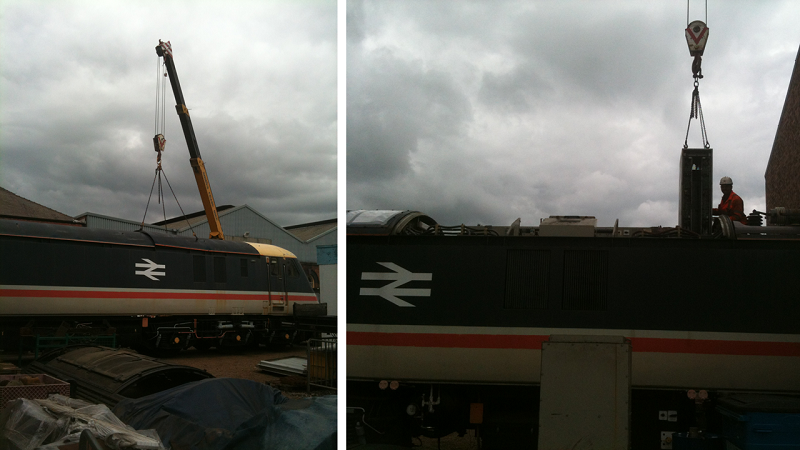The overhaul of 89001 took a major step forward today with the locomotive moving on to the lifting pad outside the HNRC workshops at Barrow Hill to have its’ Field Convertors and Rheostatic Brake Stacks removed. The complete Field Convertor cubicles will be sent for specialist electronics overhaul and testing to ensure that will ensure that each convertor is performing correctly before being returned to the locomotive. The Rheo Brake Stacks will be moved to Bowers Electrical for overhaul and repair; recent assessment work undertaken by ACLG volunteers has highlighted that there is likely to be damage to the #2 end brake stack – the resistances of a number of stages are outside of expected values.
A considerable amount of other work has also been undertaken by staff from Bralesford Engineering Services, HNRC and volunteers from the ACLG. Testing and inspection of the air brake systems has shown that it is operating correctly and the system is close to tolerance on air leakage. Specialist equipment is being developed to test the electronic ‘brake blending’ control that ensure correct operation of the friction and rheostatic braking systems.
The locomotive has been attached to various shore supplies to allow various 240V equipment to be tested; both battery chargers work and a number of the cooling fans have been test run. Last weekend, following the tracing and rectification of a short circuit on #2 end air conditioning unit it has been possible to test the air conditioning units for both cabs, achieving a cab temperature of 21C when the external temperature was 28C with air conditioning units that have stood idle for 16 years was a pleasant surprise.
The Microprocessor Control and its’ associated electronics has been surveyed, with considerable time being taken to assess the condition of individual cards and to investigate/understand the operation of the cards and the entire control system. A defect that was preventing the Microprocessor from ‘booting up’ has been repaired by the ACLG’s electronics specialist and the Microprocessor is now operating normally. The 1980s vintage Oyster terminal that is used to interrogate the Microprocessor has been replaced with modern software that is run on a laptop. Considerable efforts are being made to develop an ‘electronics strategy’ for the 89 to ensure good reliability and component resilience.
In addition to the major works and investigations there are various more general works underway including cleaning various filters, removing obsolete equipment, etc with a mixture of contractor and volunteer labour being used.
The unique and significantly ‘prototype’ nature of the 89 means in addition to the usual collection of spurious faults inherent in any locomotive under restoration there can be a number of puzzling and unusual problems, more learning for all involved – even for ex Brush staff. Whilst we have developed an extensive list of ‘areas of concern’ relating to the 89 we are pleased that in many areas the locomotive appears to work as intended.
Above Left: #1 End Rheo Brake Stack being removed (Courtesy Bralesford Engineering Services)
Above Right: #2 End Field Convertor being removed (Courtesy Bralesford Engineering Services)
